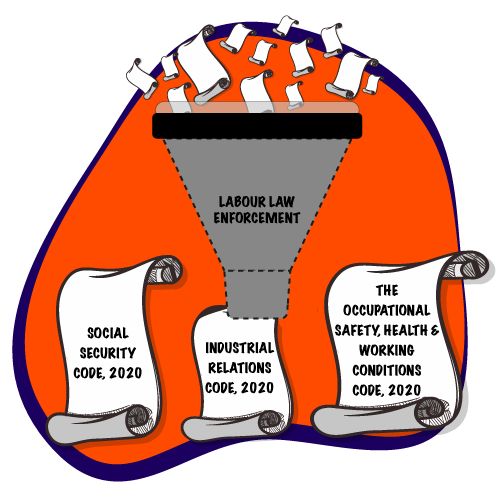The Labour Code: A Game Changer?

Trending
It is being touted as a “Game Changer” in compliance and enforcement of Labour laws in India. Of the 44 Central labour laws, 29 have been subsumed into 4 codes. 1,200 sections have been consolidated into 479 sections.
The Code on Wages Bill 2019 was passed last year and became a Law in August 2019. The Law Tree reported in its edition # 49.
Now, the Central government has notified the three labour codes after they were passed in both houses of Parliament in the recent monsoon session. The Codes on (i) Industrial relations, (ii) Social security and (iii) occupational safety, health & working conditions received Presidential assent on 28th September 2020.
The above Codes stems from the second National Commission on Labour Report in June 2002 which recommended that various labour laws be consolidated into categories such as (a) industrial relations; (b) wages; (c) social security, safety, welfare.
While the Presidential assent has been obtained, the Codes are yet to become effective. The labour ministry has proposed to make all 4 codes them effective by end of the year.
The Labour Code
The Codes on (i) Industrial relations, (ii) Social security (iii) occupational safety and (iv) Wages are simply known as the Labour Code.
An insight into the 3 Codes which were passed in September 2020.
SOCIAL SECURITY CODE, 2020
(1) The Social Security Code 2020 consolidates the following 9 legislations into one for regulating social security, employee and retirement benefits:
- The Employees Compensation Act, 1923,
- The Employees State Insurance Act, 1948,
- The Employees Provident Fund and Miscellaneous Provisions Act, 1952,
- The Employees Exchange (Compulsory Notification of Vacancies) Act, 1959,
- The Maternity Benefit Act, 1961,
- The Payment of Gratuity Act, 1972,
- The Cine Workers Welfare Fund Act, 1981,
- The Building and Other Construction Workers Cess Act, 1996, and
- The Unorganized Workers’ Social Security Act, 2008).
(2) As the name suggests, this Code is enacted to provide various social security cover,
measures and relief to various classes of workers.
(3) Highlights:
- The Code will apply to a wider section of workers / labourers including the unorganized sector, fixed term / contract employees, interstate migrant workers and the like. The government has endeavored to keep pace with the changing technology by identifying and recognizing forms of employment such as gig workers and platform workers. They have been included under this Code as well.
FACT
Gig Workers: Freelancers, Part timers, temporary contract workers such as content writers, web designers etc.
Platform Workers: Individuals using tech platform / apps such as Uber to find and service customer transport, coding and tech writers.
Unorganized workers: Migrant labourers, home based, self-employed workers.
- All social security benefits such as Provident Funds, medical insurance, life insurance, maternity benefits, pension and the like shall be extended to all classes of workers as stated above.
- The Code retains the threshold limits though. Pension, Provident fund, gratuity and medical insurance shall be mandatory only if an establishment has a minimum number of employees, say 10 or 20. For those establishments with less than the minimum number, they shall be governed by discretionary schemes notified by the Government. All eligible establishments are required to register under this Code unless they are already registered under any other labour law. Establishments that do not meet the threshold are given the option to join the fund. The Contribution under each of this scheme shall be made by both employers and employees and aggregators and gig / platform workers. The government shall notify the rate of contribution in case of aggregators such as ride sharers and food deliverers.
- The Code proposes to make ESIC mandatory for all establishment in the hazardous sector even if the threshold limit of employees is not met.
- The Code proposes to make gratuity payment for fixed term employees as well. This is unlike in the Payment of gratuity Act, 1972 which makes gratuity payment only for those employees who have put in continuous service for at least 5 years. Fixed term employees will be paid gratuity on pro rata basis even if the number of year’s service put in is less than 5 years.
- It is proposed to digitize all returns and records to be maintained and submitted by establishments. It is also proposed to maintain an online national database for unorganized sector workers. This would facilitate sharing job vacancies as well as keep track of extending benefits of various social security schemes to beneficiaries in the unorganized sector.
- The governance and implementation of the Code shall be monitored by various Central organizations and State welfare Boards headed by Commissioners / Chairperson and Ministers of the labour and employment especially in schemes governing unorganized workers.
- The appropriate government shall appoint inspectors who will also act as advisors to various establishments and facilitate compliance. Any orders / penalties passed by inspectors may be heard by administrative authorities and judicial bodies constituted under the Code.
- The Code specifies stringent penalties, fines and imprisonment for offences and non-compliance under the Code.The Code is being applauded for making the unorganized sector workers also eligible for social security benefits such as PF, insurance and health benefits. However, experts are of the view that provisions relating to computation of benefits be express which is reasonable to both the employer and employee.
INDUSTRIAL RELATIONS CODE, 2020
1. The Industrial Relations Code 2020 consolidates the following 3 legislations into one
- Trade Unions Act, 1926
- Industrial Employment Act, 1946
- Industrial Disputes Act, 1947
2. This Code is enacted to supervise and decide on industrial/ trade disputes, regulate and monitor employment conditions in industrial undertakings and establishments.
3. Highlights:
- Definitions: Some definitions have been amended while retaining most part as per the Acts.:
a. Employer – the definition will include “contractor” and legal representative of the deceased.b. Industry – the definition exempts hospitals & dispensaries, educational scientific, research and training institutions, khadi /village industries, any profession being practice individually or with a group provided number of employees are less than 10, and a co-operative society or club if number of employees are less than 10 and other social , charitable philanthropic activities.c. Industrial dispute – the definition will now include any dispute arising out of dismissal, retrenchment or termination of workers.d. Strike – the definition will now include concerted casual leave on any given day by 50% or more of the employees in an industrye. Worker – the definition has been expanded to include working journalists, other newspaper employees and sales promotion employees as defined in their respective Acts.
4. This Code must be complied by establishments having employees of 300 in number and above. Previously, the number of employees was 100. The threshold has been increased from 100 to 300 employees. Consequently, standing orders are to be framed by establishments who employ 300 workers. Similar provision applies to establishments to prepare standing orders on matters listed in the Code.
5. Employees / trade unions of ALL establishments must notify their establishments at least 14 days prior to proposed strike. Previously, this clause was applicable only to public utility services such as railways, post & telegraph departments etc. Now employees of all establishments must give prior notice of proposed strike. Similarly, Establishments must give such notice before a Lock out.
6. Industrial establishments such as factories, mines and plantation with 300 employees or more must secure prior permission from the appropriate government to lay off, retrench employees or close the Company. Previously, this was mandatory for all establishments. Now the threshold has been raised to establishments with 300 employees.
7. Industrial tribunals will replace the existing dispute redressal system. Cases will be decided either by two member or single member tribunals depending on the nature of the cases. National industrial tribunal shall be constituted to adjudicate cases of national importance or affect interests of one or more States.
8. The Code will have a built-in arbitration / dispute redressal mechanism. The arbitration and Conciliation Act 1996 shall NOT apply to such cases.
9. The Code also introduces the concept of a negotiation union or council which acts as an interface between the registered trade union and the establishment. If there is only one registered trade union, then it will be considered as the negotiation union. If there are several registered trade unions, then the trade unio with 51% of employees on the rolls of that establishment will be considered as negotiation union.
10. The appropriate government has the power to exempt any establishment from complying with the provisions of this Code.
11. The Code also incorporates setting up of a reskilling fund, contributions of which will be utilized in skill development of retrenched workers.
While the Code is being welcomed for consolidating and streamlining compliance, Employees / trade unions have been opposing it. The Code raises the threshold from 100 to 300 employees. This increases risk of arbitrary behavior by employers of establishments with less than 300 employees. They face increased threat of retrenchments, lay off and lock outs. Further the appropriate governments have been given wider powers to exempt establishments from the Code. This could be detrimental to the interests of the worker force.
THE OCCUPATIONAL SAFETY, HEALTH & WORKING CONDITIONS CODE, 2020
1. The Industrial Relations Code 2020 consolidates the following 13 legislations into one:
- The Factories Act, 1948
- The Plantations Labour Act, 1951
- The Mines Act, 1952
- The Working Journalists and other Newspaper Employees (Conditions of Service and Miscellaneous Provisions) Act, 1955
- The Working Journalists (Fixation of Rates of Wages) Act, 1958
- The Motor Transport Workers Act, 1961
- The Beedi and Cigar Workers (Conditions of Employment) Act, 1966
- The Contract Labour (Regulation and Abolition) Act, 1970
- The Sales Promotion Employees (Condition of Service) Act, 1976
- The Inter-State Migrant workmen (Regulation of Employment and Conditions of Service) Act, 1979
- The Cine Workers and Cinema Theatre Workers Act, 1981
- The Dock Workers (Safety, Health and Welfare) Act, 1986; and
- The Building and Other Construction Workers (Regulation of Employment and Conditions of Service) Act, 1996
2. This Code seeks to regulate Occupational safety, health and working conditions of workers in all establishments.
3. Highlights:
- Provisions of the Code relating shall be applicable to establishment with at least 10 workers. It will also apply to those engaged in hazardous sectors such as mines, docks etc. The term “employees” include workers, managerial, administrative staff and supervisory staff whose monthly salary is Rs. 15,000. Journalists working for e-newspapers and radio will be considered as well. Apprentices are excluded from the purview of this Code.
- The government has wide powers to exempt any class of establishment from complying with the provisions of this Code. Further the Code provides powers to the appropriate government to suspend compliance of provisions of the Code for up to 1 year due to any pandemic, natural disasters or emergency. Further the Central government has the power to amend the 3 schedules of the Code containing an exhaustive list of diseases, safety measures and protocols and hazardous processes. The government has the power to appoint inspectors to conduct inspection, inquiry and investigate accidents. In establishments in hazardous sectors, inspectors have further powers of regulating work and workforce.
- The appropriate government shall appoint registering officers with whom establishments must register within 60 days from commencement of the Code. Factories including beedi and cigar work will have to obtain license to operate. The code also proposes to introduce a single common license to hire contract labour.
- All establishments must undertake one-time registration. For all other provisions other than registration, the threshold limit for compliance is for factories with 20 workers (with power) and 40 workers (without power).
- The Code retains provisions of duties of employers in providing health and safe workplace to employees. Additionally, employer must ensure safety from hazards in high risk sectors such a mines, docks, plantations, construction sites by informing about safety protocol and providing safety equipment.
- The Code has retained provisions of the Factories Act, 1948 relating to
a. Appointment letter: to be mandatory issued by the employer to employee
b. Working hours: not more than 8 hours per day; overtime to be paid at twice the rate subject to prior consent of employees. Safety measures to be provided to employ women beyond normal working hours.c. Working conditions: safe and hygienic working conditions such as adequate lighting & ventilation, clean drinking water, toilets and space. Welfare facilities such as creche, canteen and health checkups / medical facilities to be provided.
d. Leave entitlement: Nearing 3 weeks of leave per year to be provided to employees.
4. To enable interstate migrant workers to register themselves on portals to become eligible for ration and other benefits in the destination State.
5. Occupational safety and health advisory Boards shall be set up by the Central / State government that advise the respective government on matters of implementing the Code.
6. At the discretion of the Central / State government, Safety committees may be set up. Representatives of employers and workers will form the Committee. The committee will liaison between the employer- employee to ensure consistency in interpretation of the Code and implementation of policies to mutual benefit.
Like in the previous Codes, while the objective and intent are lauded, the sweeping powers given to government to exempt or apply the code to establishments has not been welcomed for the fear of dominance by the government authorities.
Fruit of Labour: Bittersweet
The Acts were last amended in the 70’s. The consolidation of 29 out of 44 central labour laws into 4 Codes has been commended. A total of 1,200 sections have been concise into 479 sections across the 4 Codes.
However, stakeholders particularly trade unions have been unanimous in voicing their dissent on changes in the Codes.
The Codes were passed in the monsoon session of parliament of both house with limited/ minimal debate due to the ongoing Covid19 pandemic. Some provisions which were not in the 2019 Bill was included just before passing in the Lok Sabha and Rajya Sabha. The main bone of contention: Giving sweeping powers to the appropriate government to decide on including or exempting establishments from the Codes 2020. Interest of the employees / workers may be at stake. With the government claiming that the reforms would give an impetus to the industry/ economy, it intends to reduce burden of compliance of multifarious labour laws. All eyes are on the government for effective implementation of the Labour Codes 2020.

